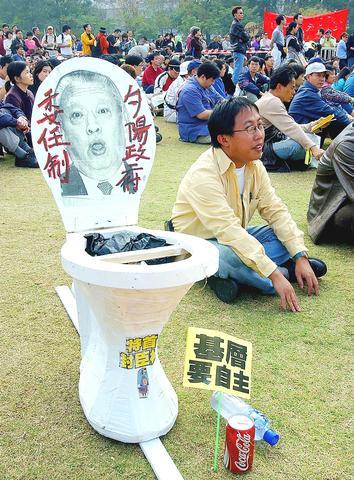Thousands of people marched through downtown Hong Kong on New Year's Day to demand full democracy in this former British colony, the biggest rally since a mass protest in July that threw the government into crisis.
Chanting "return power to the people," about 100,000 protesters marched from an urban park to the government headquarters, according to organizers. Police declined to provide their own crowd-size estimate, and there was no way to confirm the figure.

PHOTO: AP
The demonstration was seen as a crucial barometer of public sentiment, exactly six months after a half-million people took to the streets denouncing an anti-subversion bill proposed by the Hong Kong government, and backed by Beijing, as a threat to freedom.
"We have made history again!" said rally spokesman Richard Tsoi.
Yesterday's turnout exceeded predictions by organizers, who said earlier that people would have less impetus to protest this time.
The government's controversial proposal was shelved in October, and Hong Kong's economy -- another source of public discontent -- appears to be on the rebound.
Marchers -- many of whom also protested on July 1 -- said that wasn't enough.
"Democracy is something we need to maintain a fair society," said 40-year-old Connie Yau, a civil servant.
Since coming under Chinese rule in 1997, Hong Kong has enjoyed Western-style freedoms unheard of on the mainland, but remains only partially democratic.
Hong Kong's top leader Tung Chee-hwa (
Protesters yesterday heaped criticism on Tung, who has faced calls for his resignation over the anti-subversion bill and alleged economic mismanagement.
"Tung hasn't listened enough," said businessman Steve Lee.

LIMITS: While China increases military pressure on Taiwan and expands its use of cognitive warfare, it is unwilling to target tech supply chains, the report said US and Taiwan military officials have warned that the Chinese People’s Liberation Army (PLA) could implement a blockade within “a matter of hours” and need only “minimal conversion time” prior to an attack on Taiwan, a report released on Tuesday by the US Senate’s China Economic and Security Review Commission said. “While there is no indication that China is planning an imminent attack, the United States and its allies and partners can no longer assume that a Taiwan contingency is a distant possibility for which they would have ample time to prepare,” it said. The commission made the comments in its annual

DETERMINATION: Beijing’s actions toward Tokyo have drawn international attention, but would likely bolster regional coordination and defense networks, the report said Japanese Prime Minister Sanae Takaichi’s administration is likely to prioritize security reforms and deterrence in the face of recent “hybrid” threats from China, the National Security Bureau (NSB) said. The bureau made the assessment in a written report to the Legislative Yuan ahead of an oral report and questions-and-answers session at the legislature’s Foreign Affairs and National Defense Committee tomorrow. The key points of Japan’s security reforms would be to reinforce security cooperation with the US, including enhancing defense deployment in the first island chain, pushing forward the integrated command and operations of the Japan Self-Defense Forces and US Forces Japan, as

‘TROUBLEMAKER’: Most countries believe that it is China — rather than Taiwan — that is undermining regional peace and stability with its coercive tactics, the president said China should restrain itself and refrain from being a troublemaker that sabotages peace and stability in the Indo-Pacific region, President William Lai (賴清德) said yesterday. Lai made the remarks after China Coast Guard vessels sailed into disputed waters off the Senkaku Islands — known as the Diaoyutai Islands (釣魚台) in Taiwan — following a remark Japanese Prime Minister Sanae Takaichi made regarding Taiwan. Takaichi during a parliamentary session on Nov. 7 said that a “Taiwan contingency” involving a Chinese naval blockade could qualify as a “survival-threatening situation” for Japan, and trigger Tokyo’s deployment of its military for defense. Asked about the escalating tensions

The Ministry of Economic Affairs said it plans to revise the export control list for strategic high-tech products by adding 18 items under three categories — advanced 3D printing equipment, advanced semiconductor equipment and quantum computers — which would require local manufacturers to obtain licenses for their export. The ministry’s announcement yesterday came as the International Trade Administration issued a 60-day preview period for planned revisions to the Export Control List for Dual Use Items and Technology (軍商兩用貨品及技術出口管制清單) and the Common Military List (一般軍用貨品清單), which fall under regulations governing export destinations for strategic high-tech commodities and specific strategic high-tech commodities. The